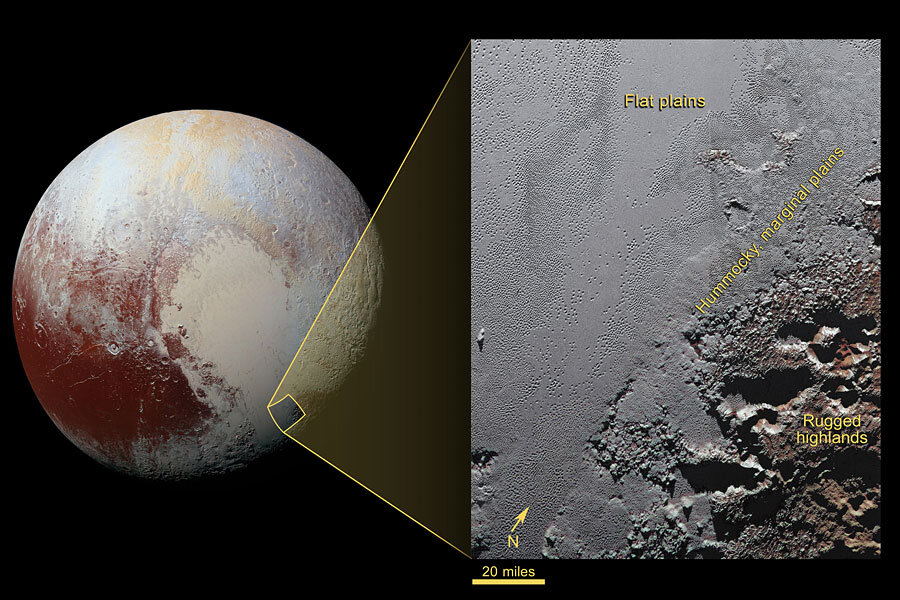Newest photo of Pluto stuns scientists
Loading...
The New Horizons spacecraft is currently cruising almost 250 million miles beyond Pluto. But that doesn't stop it from continuing to beam breathtaking images back to Earth from its flyby of the dwarf planet, nearly a year ago.
NASA just released the latest of these images, a high resolution look at Pluto's surface that shows much more diverse terrain than scientists anticipated.
There's a sharp dividing line where the smooth, flat ice plains in the southern part of Pluto's "heart" abut dark, rugged, mountainous highlands that rise 1.5 miles above the plains.
"It's like two pieces of a puzzle that are fit together in a way you would never expect to find," Richard Binzel, professor of planetary science at Massachusetts Institute of Technology in Cambridge, Mass., tells The Christian Science Monitor. "It's very hard to understand how you can get such a sharp, contrasting line on a planetary world, especially one we thought may have been cold and inactive. It seems, in fact, Pluto is alive."
The absence of impact craters on the icy plains, dubbed Sputnik Planum, suggests that they are very young, at least in the scale of Pluto's existence. Alan Stern, principal investigator of the New Horizons mission, estimates that they were created in the last few million years, which make up just a fraction of one percent of Pluto's existence.
But the dark, mountainous region bordering the plains, nicknamed Krun Macula after the Mandaean lord of the underworld, dates back billions of years, to Pluto's youth, Dr. Stern says in a phone interview with the Monitor.
Why the sharp dividing line?
"It's completely perplexing, and that's part of what’s awesome about it," Stern says. "As a scientist you like to be stumped because it's telling us more important new things about the way small planets work than we could have guessed before the flyby."
The image also reveals a diversity of colors: a gray background with varying degrees of red.
"The red we believe are particles from the atmosphere. Why they're distributed the way they are, in certain areas but not in others, is part of the mystery. It may have to do with erosion rates on the surface, for example, but it's a little too early to tell," says Stern.
The just-released image is a mosaic created from three separate snapshots taken in July 2015 when the New Horizons spacecraft passed about 21,000 miles from Pluto.
As the Monitor previously reported, scientists are starting to develop an explanation for another surprising feature spotted in one of New Horizons' earliest images of the dwarf planet. Two teams of scientists separately reached the same explanation about interlocking polygons that appear to be etched across the surface of Sputnik Planum, the western lobe of Pluto's iconic "heart": Pluto's surface is churning.
There are more images of Pluto to come. So far, New Horizons has transmitted about 70 percent of its data on Pluto back to Earth, says Stern.
The New Horizons spacecraft has already revolutionized scientists' understanding of Pluto. It's the first scientific investigation to get a close look at Pluto and its largest moon, Charon, allowing scientists to gain insight into the processes that shaped Pluto.
"Previously Pluto was literally a speck of light. We had a few detailed images showing that its surface was different colors from the Hubble Space Telescope, and there were some blurry patches," Anne Verbiscer, a professor of astronomy at the University of Virginia, tells the Monitor. "But to see the incredible detail from a flyby from a spacecraft – that's just overwhelming."








